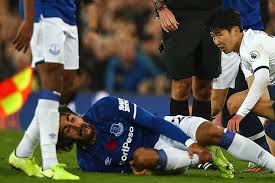By Andrew Warshaw
November 4 – The inconsistency of VAR in English top-flight football plummeted to new depths of confusion and misinterpretation on Sunday accompanied by one of the most bizarre red card decisions of recent years.
Some of the officiating in Everton’s 1-1 draw with Tottenham bordered on the farcical, with the entire second half ruined by technology that was brought in supposedly to create clarity and fairness but has reached a point where it has to be tightened up – or scrapped altogether.
Not one, not two but three VAR penalty decisions led to unnecessary stoppages – one ridiculously of more than three minutes – that would been rectified far more quickly and accurately had the referee simply taken a quick glance at the pitch-side monitor which, throughout the Premier League season, has been inexplicably rendered redundant and replaced by VAR officials in a studio hundreds of miles away.
The whole concept of what is and what isn’t a “clear and obvious” error, which is supposed after all to be the raison d’etre of VAR, is now in itself a grey area. It makes a mockery of the entire exercise which could be made so much easier if only VAR communicated with the officials and told them to consult the monitor if they think there has been an error.
If they can’t decide within a specific amount of time whether the offense is clear and obvious, then go to VAR. It isn’t rocket science and beggars belief why a system that is supposed to afford referees time to have second look is being completely ignored.
Yet all three penalty decisions on Sunday – at least one of which should have been awarded to Everton under the letter of the law but wasn’t – paled into insignificance compared to the bombardment of reaction, much of it on social media, that accompanied a red card handed to Tottenham’s Son Heung-min following an horrific and most likely season-ending injury to Everton’s Portuguese midfielder Andre Gomes that had distraught players and officials on both sides fearing for his well-being.
The referee at first handed Son a yellow card for a foul on Gomes but, once the extent of the Everton man’s injury had been ascertained, changed his mind and incredibly handed a red to the South Korean who was arguably more distressed than anyone and had to be consoled by team-mates as he left the pitch in floods of tears.
Television pictures showed that the way Gomes fell indicated clearly that the devastating injury was not caused by the foul itself. His studs seemed to catch in the turf which is how his ankle appeared to break before he collided with another Tottenham player, Serge Aurier. Only then was Son red-carded – for the hugely unfortunate consequences of what happened next rather than for the far-from-brutal challenge itself.
In a bizarre statement, the Premier League, in an attempt to protect the referee and justify the decision, explained: “The red card for Son was for endangering the safety of a player which happened as a consequence of his initial challenge.”
In other words, we thought it was a yellow but the injury was so bad we gave him a red.
Since when has that been how matches are refereed? The last time I looked it was not part of the laws of the game.
Tottenham manager Mauricio Pochettino, like everyone else involved, expressed his deepfelt condolences for Gomes, who left the field on a stretcher, but also defended his player.
“We feel very sorry, we feel very sorry because it was a really bad situation,” he said. “It was very bad luck how he (Gomes) landed in the action. We can only send our best wishes and of course we are devastated for the situation. (But) it was clear it was never the intention of Son for what happened. It is unbelievable that he saw a red card.”
The irony is that if VAR had intervened, it may well have exonerated Son. We will never know. Curiouser and curiouser…
Contact the writer of this story at moc.l1741604851labto1741604851ofdlr1741604851owedi1741604851sni@w1741604851ahsra1741604851w.wer1741604851dna1741604851

